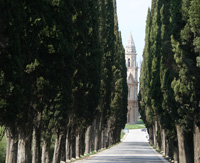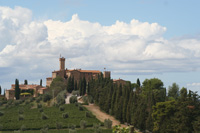| Montalcino |
The quiet Tuscan village of Montalcino has undergone few changes since medieval times, when it was a stronghold pertaining to the nearby city of Siena. Montalcino was once a strategic point along the road to Rome and offers a panoramic view of the beautiful Asso, Orcia and Ombrone valleys. The town’s fame derives from its production of one of Italy’s finest red wines known as Brunello di Montalcino. |
||||
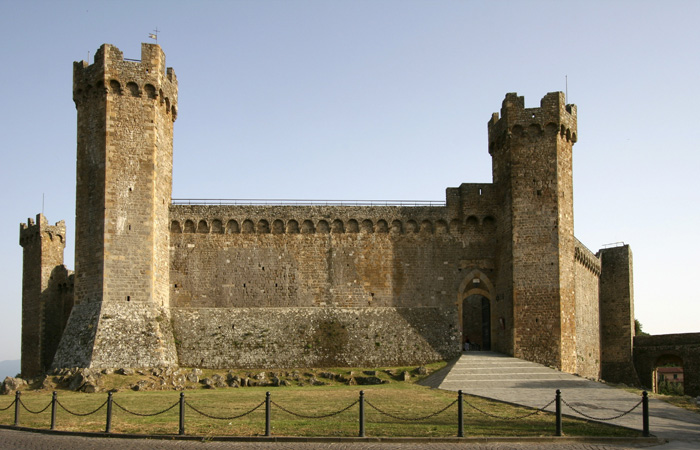 |
||||
The picturesque fourteenth-century Fortress of Montalcino
|
||||
| Down the narrow, short street (Via Ricasoli) that extends from the main gate of the fortress is the Chiesa di Sant'Agostino with its simple Romanesque façade, also built in the 13th century. The building adjacent to the church is a one-time convent, but it is now the home of the Musei Riuniti which is both a civic and diocesan museum. The museums hold various works, including a gorgeous wooden crucifix by an unknown artist of the Sienese school, two beautiful 15th century wooden sculptures, including one of an incredibly moving Madonna by an anonymous artist which has become the symbol of Montalcino on the various posters and pubblicity, and several other sculptures in terracotta which appear to be of the Della Robbia school. The collection also includes a St Peter and St Paul by Ambrogio Lorenzetti and a Virgin and Child by Simone Martini. There are also more modern works from the beginning of the 20th century that offset and reflect the older works of art in the artful way they are presented by the curator. The Duomo (cathedral), dedicated to San Salvatore, was originally built in the 14th Century, but it now has a neo-classical appearance thanks to extensive renovation work that was done in the early 19th century under the direction of Sienese architect Agostino Fantasici. The Piazza della Principessa Margherita, is down the hill from the fortress and Duomo on the via Matteotti. The principal building on the piazza is the town hall, once the Palazzo dei Priori (built late 13th, early 14th century) which was for many years the Palazzo Comunale. The palace is adorned with the coats of arms of the Podesta who once ruled the city. A very high medieval tower is incorporated into the palazzo. Close by is a Renaissance structure with six round arches, called La Loggia, which was started at the very end of the 14th century and finished in the early 15th, but which has undergone much restoration work over the subsequent centuries. Montalcino is divided, like most medieval Tuscan cities, into quarters called contrade, Borghetto, Travaglio, Pianello and Ruga, each with their own colours, songs and separate drum rhythms to distinguish them. Twice a year they meet together in a breath taking archery contest under the walls of the Fortezza, conducted in Medieval dress, with lords and ladies of each contrada who accompany the proceedings. The thirteenth-century church of San Francesco in the Castlevecchio contrada has undergone several renovations. Some of the interior frescoes were done by Vincenzo Tamagni in the early sixteenth century. There are many other medieval buildings in Montalcino that make up its centro storico (historical center). As with many other similar cities, money from tourism is aiding the cause of restoration and preservation. In 2010, the Festa Europea Della Musica had its first edition in Montalcino, to underscore and promote the beauty and culture of the town, and develop the artistic presence in the territorio as an "abbinamento" to the immense quality of its wines and way of life. Associated with the Fête de la Musique, created by Jack Lang in Paris in 1981 to celebrate music and musicians, the Festa was incorporated into the Italian Minister of Culture's agenda in 1994, and has since spread across Italy as well as the world, encouraging the cooperation and musical exchanges between the participating cities. Celebrated on the 21st of June, the entire town and its "frazioni" become one varicoloured musical tapestry that offsets beautifully the jewel of the territory itself.
|
|
|||
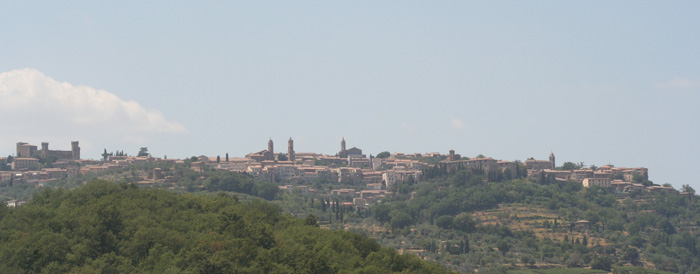 |
||||
Montalcino |
||||
| History |
||||
The hill upon which Montalcino sits has been settled probably since Etruscan times. Its first mention in historical documents in 814 AD suggests there was a church here in the 9th century, most likely built by monks who were associated with the nearby Abbey of Sant'Antimo. The population grew suddenly in the middle of the tenth century when people fleeing the nearby town of Roselle took up residence in the town.
|
||||
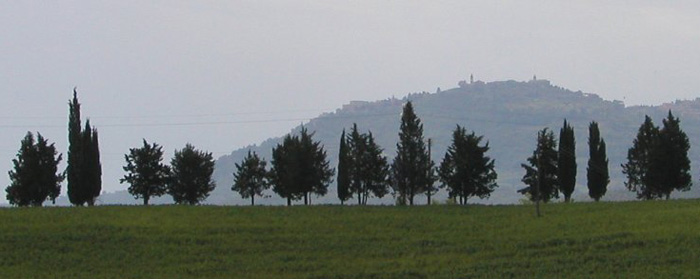 |
||||
Montalcino, surroundings
|
||||
|
||||
|
|
||||
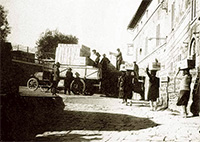 |
 |
|||
|
Brunello Crossing in Montalcino, the second weekend of February
|
Fortress of Montalcino
|
||
 |
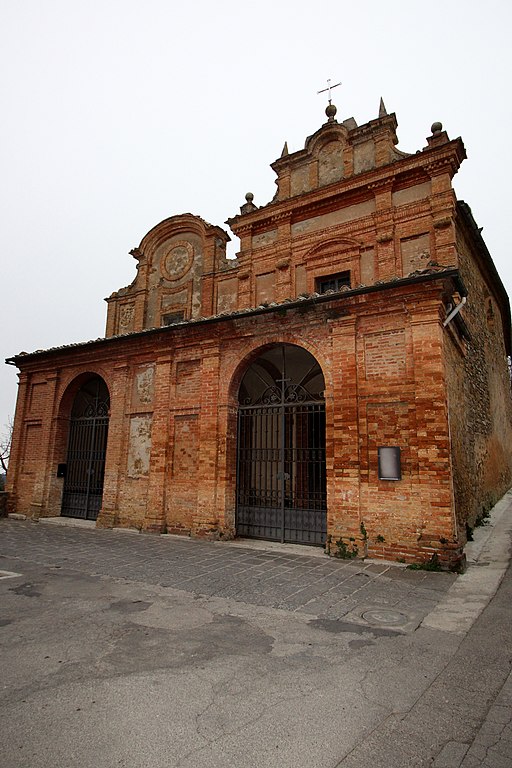 |
 |
||
Palazzo dei Priori a Montalcino
|
La chiesa di Sant'Antonio, facciata
|
The gates of Montalcino
|
||
 |
 |
 |
||
Chiesa di Sant'Agostino
|
Panorama con la chiesa di San Francesco
|
Cypress trees between San Quirico d'Orcia and Montalcino
|
||
|
|
||||
 |
 |
|||
Pienza
|
Camigliano
|
Val d'Orcia album
|
||
 |
 |
 |
||
View on Sant'Angelo in Colle
|
Poggio alle Mura, Cimitero
|
L'Abbazia di Sant'Antimo, l'abside della chiesa originaria
|
||
 |
||
Pietro Lorenzetti, Annunciazione dei Santi in the Chiesa di San Michele in Castiglione del Bosco Pietro Lorenzetti paints the fresco "Annunciazione dei Santi" in the Church of San Michele in Castiglion del Bosco's Il Borgo. It was rediscovered in 1876 and fully restored to its original glory. Pietro and his brother, Ambrogio Lorenzetti, who painted the Allegory of Good Government and Bad Government fresco in the Palazzo Pubblico in Siena, belonged to the famous Sienese School which flourished during the late Middle Ages and foreshadowed the art of the Renaissance. |
||
The abbey of Sant’Antimo |
||
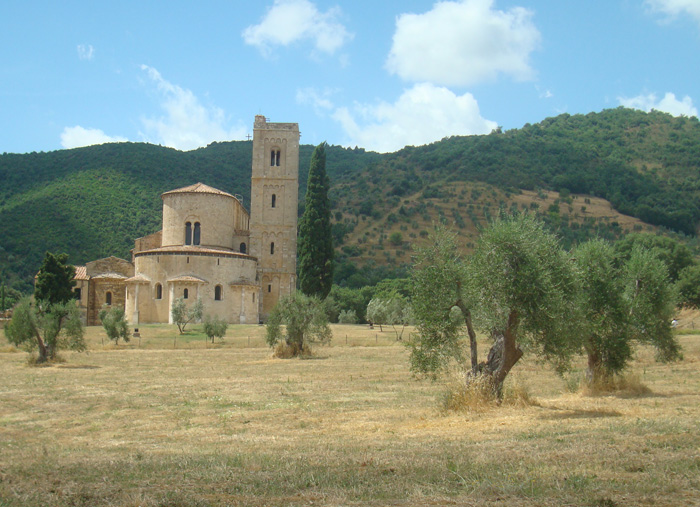 |
||
The Abbey of Sant'Antimo |
||
The Abbey of Sant'Antimo, in a picture-perfect setting, just about 26 km north of Podere Santa Pia, and 10 km south of Montalcino, dates from the 12th century. It's one of the finest Romanesque religious buildings in Italy. Nearby the town of Sant'Angelo in Colle, an enchanting well-preserved village on the top of a hill contained in its circle of walls. From the Abbey of Sant'Antimo, a footpath (6 km) leads to Sant’Angelo in Colle. |
||
| The façade, which remains incomplete, houses a portal, probably one of a pair planned originally, surmounted by a lintel datable to the first half the 12th century, together with capitals, friezes and ferrules. The element that confers a French imprint on this church more than any other is the basilical ground plan, an ambulatory with radial chapels, unique in Tuscany and among the few present in Italy. A study of Sant’Antimo was made by the art historian Raspi-Serra, and completed in the 1960’s. It brought us to conclude that the portal on the left side of the church of Santa Maria in San Quirico d’Orcia (approximately 20 km from Saint’Antimo), is none other than one of the two portals intended for the abbey. Perhaps the monastery, at that time, already in a state of decline, decided to give over the second portal to this other church. The entrance has a high arch, and bas-relief decorations. Particularly interesting is the small doorway to the left; this dates back to the 9th century. Also on this side is the Bell Tower, with single-light and double-light windows. One of the bells dates back to 1219. The pre-Romanesque primitive chapel is visible on the right. The interior has three naves separated by high columns, alternated with pilasters in clusters in the lower part and twin lancet galleries above. The capitals in marble from the nearby Castelnuovo quarry are decorated with floral, human and geometric figures. The apse has radial chapels joined by an ambulatory, as in French Cathedrals. The church is guarded at the entry by two stylised lions, probably destined for the external portal, datable to the 12th century and attributed to the Master of Cabestany, as is the splendid capital with the scenes of Daniel in the lions." The refined geometrical and leaf motifs, precise in outline and cleanly carved, indicate an origin in Auvergne. To the right of the larger church, set at the beginning of the ambulatory, there is a Carolingian chapel of the 8th or 9th century, a small building with a single rectangular aisle and a semicircular apse. Outside on the left, the imposing bell tower rise to around 30 m, divided into four orders, decorated in Lombard style with a with a hint of Pisan taste in the columns at the angles of the base. The bell tower houses two bells, one of which is engraved with Abbot Ugo's name (1216-1222) and the date 1219. |
The church is guarded at the entry by two stylised lions, probably destined for the external portal, datable to the 12 C and attributed to the Master of Cabestany, as is the splendid capital with the scenes of Daniel in the lionsden." The refined geometrical and leaf motifs, precise in outline and cleanly carved, indicate an origin in Auvergne.
|
|
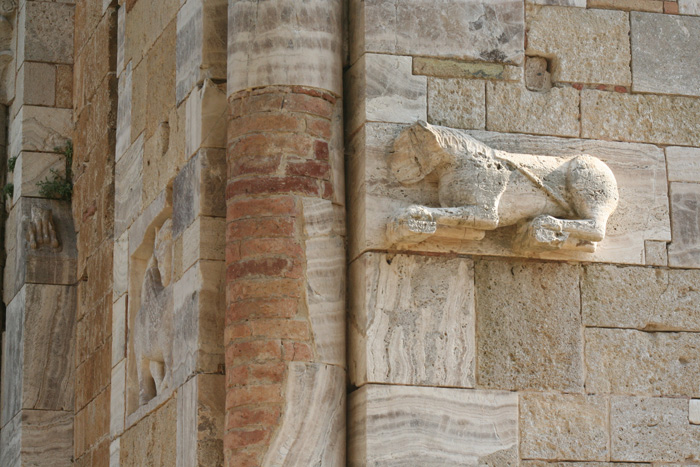 |
||
The Abbey of Sant'Antimo was constructed on the site of a Roman villa. In the 4th and 5th centuries the village of Castelnuovo dell'Abate, on the hills nearby, was an important inhabited centre, endowed with a parish. Pieces recycled from the villa were reused in the church and are still visible in the tower. |
||
The commune Montalcino is made up of four urban centers: Montalcino, San Angelo in Colle, Castelnuovo dell’Abate and Torrenieri; Although only 16km in diameter,the altitude and soil composition vary throughout its sub-regions.
|
||
Sant’Angelo in Colle |
||
The Blue Guide also mentions the town of Sant'Angelo in Colle, as being an "enchanting well-preserved village on the top of a hill ... contained in its circle of walls". You can drive there on a white road (dirt road) from Sant'Antimo or on a paved road from Montalcino.
|
||
 |
||
View on Sant'Angelo in Colle [1]
|
||
| Sant'Angelo in Colle is located in the southwestern subzone of the Brunello di Montalcino and Rosso di Montalcino appellation. Sant'Angelo in Colle is a typical medieval village situated on a hill (450m) within the Natural Park of Val D’Orcia (included by UNESCO into the list of the World Cultural and Natural Heritage). Sant'Angelo in Colle is called Sant'Angelo in Colle or Saint Angel on the Hill because it is one of the highest elevations points in the appellation of Montalcino. This small village offers two of the best restaurants in the Montalcino area, Il Leccio and Trattoria Il Pozzo. Sant'Angelo Scalo further down the mountain has a good butcher en an excellent small restaurant, Caffe' Sant'Angelo, the locals' first choice when it comes to authentic Tuscan cuisine.
|
|
|
| Since the 11th century, the medieval fortress Castello di Velona has been guarding over the Via Clodia, the ancient road built to connect Etruria with Rome. The origins of the castle Velona takes away the 11th century, which originally functioned as a protective fortress, then a luxurious villa of the aristocratic, and by the end of the XX century has turned into a luxury hotel. |
||
San Quirico d’Orcia |
||
| San Quirico d’Orcia is situated on a hill slope between the Orcia river and the Tuoma torrent valley. Getting into San Quirico, walking from north through the Dante Alighieri street, you can find the Collegiata Church, a spended building from the XII century. Near the Church you can find the Palazzo Chigi, that hosts now the municipal building, built in the XVII century, Inside the palazzo there are a lot of beautiful wall paintings and at the first floor it hosts the Italian Garden Archive. In front of it you can find the Palazzo Pretorio, where the Natural Artistic and Cultural Park of Val d’Orcia comitee is located. Walking towards south you'll hit the Piazza della Libertà, San Quiricos' main square, with the San Francesco Church and the Porta Nuova, the ancient access to the village. In the same square there are Horti Leonini , a typical garden from the XVI century. During the summer there are a lot of cultural activities in it, such as the “Forme nel Verde”, an important international sculpture exhibition. |
||
| The Val d’Orcia Unesco Worldwide Humanity Heritage The Val d’Orcia is an important natural, artistic and cultural park and from 2nd july 2004 is declared Unesco Worldwide Humanity Heritage, because of its excellent inspiration for many artists from Middle Ages on. The Val d’Orcia deeply influenced the development of the landscape celebrated by senese’s school painters which flourished during the Renaissance. Images of the Val d’Orcia, and particularly depictions of landscapes where people are depicted as living in harmony with nature, have come to be seen as icons of the Renaissance and have profoundly influenced the development of landscape thinking. The Val d’Orcia, or Valdorcia extends from the hills south of Siena to Monte Amiata. It is characterised by gentle, carefully cultivated hills occasionally broken by gullies and by picturesque towns and villages such as Pienza (rebuilt as an “ideal town” in the 15th century under the patronage of Pope Pius II), Radicofani (home to the notorious brigand-hero Ghino di Tacco) and Montalcino (the Brunello di Montalcino is counted among the most prestigious of Italian wines). The Val d’Orcia is an important natural, artistic and cultural park and from 2nd july 2004 is declared Unesco Worldwide Humanity Heritage, because of its excellent inspiration for many artists from Middle Ages on. |
||
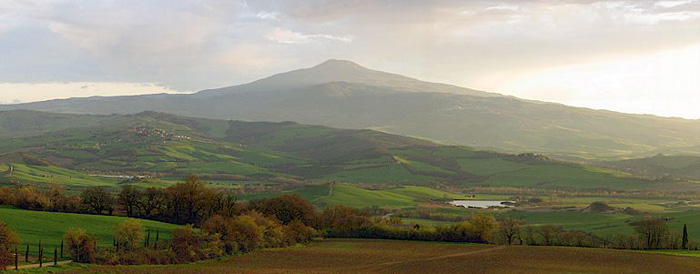 |
||
The Val d'Orcia between Pienza and Monte Amiata, view to the west from La Foce. The territory of the Val d'Orcia is made up, mainly of a hilly landscape with gently rolling hills and valleys typical of the Sienese Crete and a rich variety of vegetation. |
||
View Larger Map |
||
| Camigliano, Castelnuovo dell'Abate, S.Angelo in Colle, S. Angelo Scalo, Torrenieri and Tavernelle are frazioni of Montalcino. |
||||
|
||||
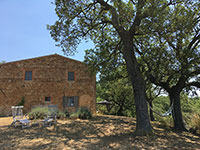 |
||||
|
||||
Early morning light at the private swimming pool at Podere Santa Pia
|
A bigger splash in swimming pool at Podere Santa Pia, southern Tuscany
|
A bigger splash in the pool, Podere Santa Pia, Castiglioncello Bandini, Cinigiano, Tuscany
|
||
Monte Cucco wine region |
Podere Santa Pia |
Colline sotto Podere Santa Pia
|
||
| Duomo di Montalcino, la cattedrale di San Salvatore
|
||||
Podere Santa Pia, a formal cloister in the Tuscan Maremma is situated on the outskirts of Castiglioncello Bandini and dominates one of the most beautiful setting that nature can offer: the Tuscan countryside. Explore the medieval hillside villages of Pienza, Monticchiello, Civitella Paganico or Castelmuzio, watch the Ponte della Pia near the Eremo di Rosia and marvel at settlements that date back to Etruscan times,such as Sorano, Sovana and Pitigliano. And of course taste the famous local wines in Montepulciano or Montalcino, cities where the refined beauty of the squares and churches blends perfectly with the ancient traditions of its wines.
|
||||
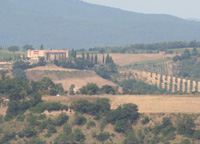 |
||||
Rocca di Tentennano |
Castello Colle Massari, view from Podere Santa Pia |
Castel Porrona, a charming medieval village dating back to the 11th century, between Cinigiano and Castiglioncello Bandini and Podere Santa Pia |
||
| Montalcino Restaurants |
S.Angelo in Colle Restaurants | |||
| Re di Macchia Osteria di Porta al cassero La Crocina Castello Banfi La Taverna Taverna del Grappolo Blu |
Il Giglio Ristorante Al Giardino Ristorante Trattoria L'Angolo Locanda Demetra Il Moro Camigliano Il Galletto Di Camigliano
|
S.Angelo Scalo Restaurants On the main street of Scalo is the Caffè Sant’Angelo, owned by Pino and Daniela. A place where Italians eat on a daily basis. This is always an excellent indicator of value and quality.
|
||
This page uses material from the Wikipedia articles Abbey of Sant'Antimo, Montalcino, published under the GNU Free Documentation License. |
||||
|
||||
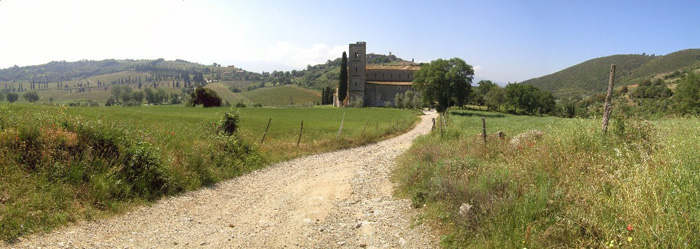 |
||||
Nearby the town of Sant’Angelo in Colle, 6km from Sant’Antimo, an enchanting well-preserved village on the top of a hill contained in its circle of walls. You can drive there on a dirt road from Sant’Antimo or on a paved road from Montalcino
|
||||
| Walking in the Val d'Orcia | Itineraries
|
||||
There is a hiking trial from Sant'Antimo which takes you up into the woods towards Montalcino.
|
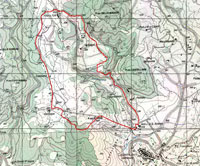 |
|||
| Castelnuovo dell'Abate - Vivo d'Orcia |
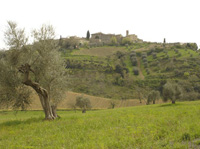 Castelnuovo dell'Abate Castelnuovo dell'Abate |
|||
This spectacular itinerary descends from the Abbazia di Sant'Antimo, surrounded by silence and Brunello vineyards, then climbs up the pristine slopes of Monte Amiata, an ancient extinct volcano. The trip ends up in Vivo d'Orcia, one of the most well-conserved and verdant localities in Tuscany, charged with energy from the volcano.
|
||||
The best itineraries around Montalcino
|
||||
Walk around Pienza | Montepulciano - Pienza Walk around Pienza |
||||
The trail starts on the Piazza Dante Alighieri in Pienza, and continues along the Viale Santa Caterina that leads to the Pieve di Corsignano, an exceptional example of Romanesque art just outside of the city walls of Pienza. Admire the carvings on the side of this ancient structure, which dates possibly from the 10th century. This was Pienza's original parish church.
Montepulciano - Pienza | 11 km, 3 hours
|
|
|||
Maps and descriptions available in Podere Santa Pia Kompass map 653 Pienza - Montalcino - Monte Amiata (1:50.000) |
||||
 |
||||
Podere Santa Pia, situated in a particularly scenic valley, which overlooks on the hills around Cinigiano,
up to the Maremma seashore and Monte Christo |
||||
The Maremma is a large area in southern Tuscany. It is a perfect microcosm that stretches between the provinces of Livorno and Grosseto. In the Divine Commedy, Dante Alighieri identified its borders from "Cecina to Corneto" (Tarquinia in Lazio). Maremma is unique because of the variety of its territory: blue sea, long beaches, black rock, hills covered with woods, marshes and flat lands, green hills and natural thermal baths. |
||||
|
||||
The castle of Poggio alle Mura, or Banfi Castle, is a family-owned vineyard estate and winery in the Brunello region of Tuscany. The origin of the fortress can be traced to the ancient Etruscans, but its deepest historical niche was carved during the Middle Ages. The Renaissance Romanesque structure served as the Republic of Siena's first line of defense against attack from the south and, in 1260 A.D., it was awarded to Placido Placidi, hero of the "Battle of Montaperti," which was immortalized by Dante in the "Divine Comedy." The castle's historical name is Poggio alle Mura. Torrenieri | Brunello di Montalcino wineries on the northern-east slopes of Montalcino
|
||||
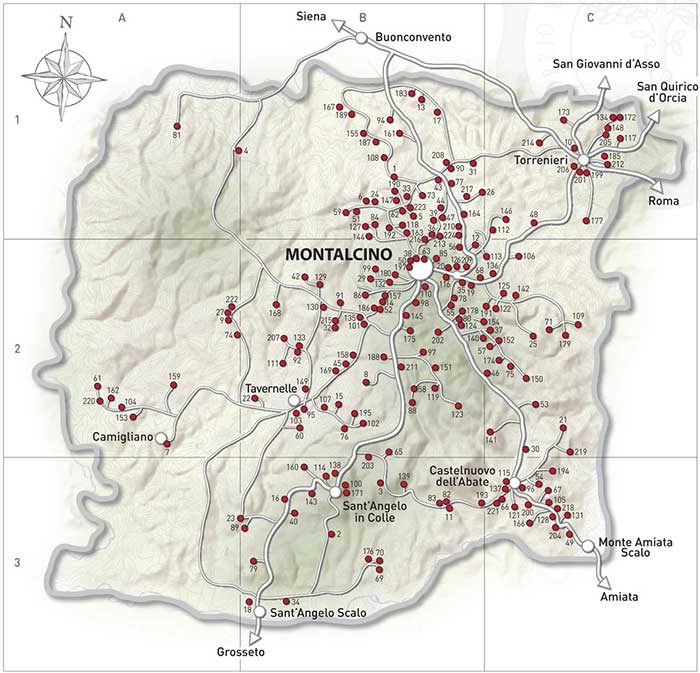 |
||||
| Member companies of the DOCG Brunello di Montalcino [1] |
||||
| A B C D E F G H I J K L M N O P Q R S T U V W Z | ||||
Consorzio del vino Brunello di Montalcino | Digital map with all affiliated producers of Brunello di Montalcino
|
||||

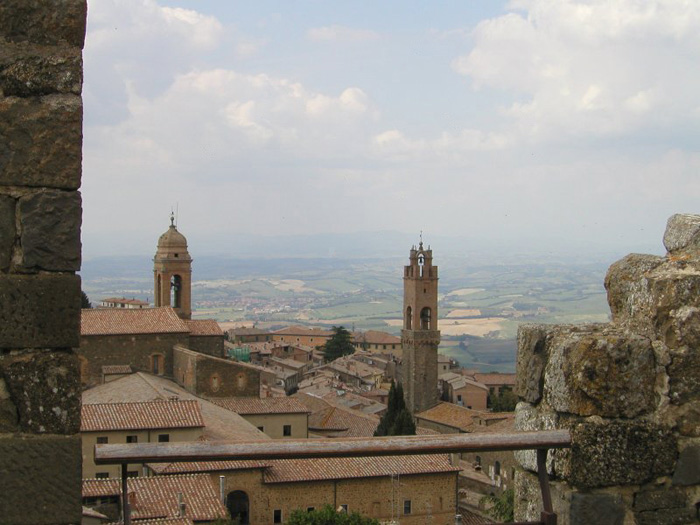
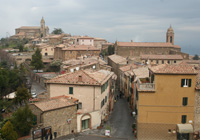

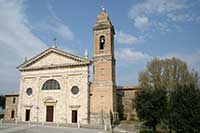


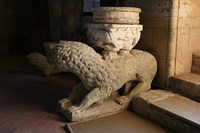
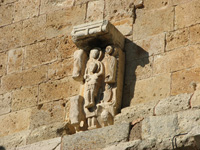
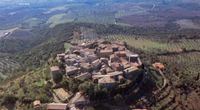
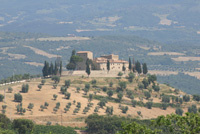
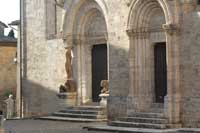





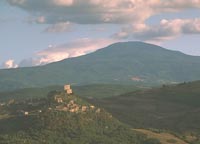
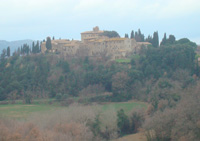
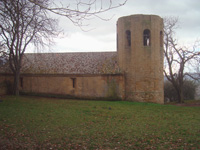 Pieve di Corsignano
Pieve di Corsignano 